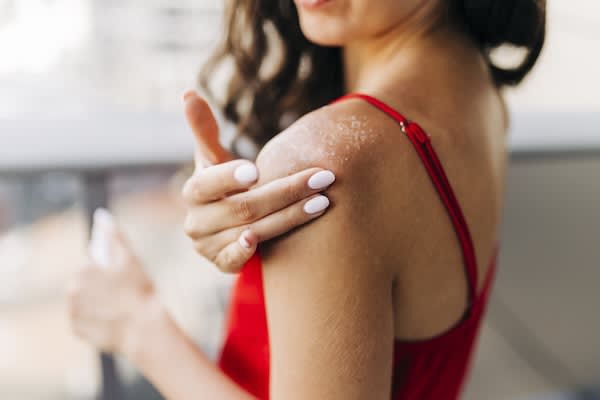Melanoma: A primer for summer

[4 MIN READ]
In this article:
-
Melanoma only accounts for 1% of skin cancers, but it’s responsible for most skin cancer deaths. It’s also typically an aggressive form of cancer.
-
Understanding melanoma’s dangers is a key part of prevention. Take steps to protect your skin from the sun’s damaging rays year-round, not just on sunny, summer days.
-
New forms of immunotherapy are helping doctors fight melanoma.
Melanoma: A primer for summer
Warm sunshine on the skin can feel magical after a long, gray winter. Yet now that summer is here, it’s a good time to cast a light on melanoma, the most serious and deadly form of skin cancer — and understand why it’s important to protect yourself from dangerous ultraviolet (UV) rays not just this season, but all year long.
Kelly Paulson, M.D.,Ph.D., a medical oncologist at Providence Swedish Cancer Institute in Seattle, recently joined the podcast team for an episode of Cancer, Cures & Coffee to talk about melanoma, which accounts for only 1% of skin cancers but is responsible for most skin cancer deaths.
What to know about melanoma
Melanoma is a form of skin cancer caused by changes in the cells that make skin pigment, called melanin.
Melanoma is typically aggressive, tending to grow quickly and spread to other parts of the body. Also, while it’s the rarest type of skin cancer — diagnosed in about 100,000 people each year in the United States —melanoma cases continue to climb.
“In the United States, we have considerably more melanoma now than we did 20 years ago,” Dr. Paulson says.
Most melanomas are caused by exposure to the sun’s ultraviolet (UV) rays. That means they’re preventable, Dr. Paulson says. They’re also treatable when caught early, with new, effective therapies approved by the Food & Drug Administration in recent years.
Prevention
Having five or more sunburns in your life doubles your risk of developing melanoma. It’s a scary statistic, but it underscores why understanding the importance of skincare and melanoma’s dangers is a key part of prevention. The effects of sun damage can take years to appear, sometimes even decades. That’s why it’s critical to protect yourself and your loved ones from a young age.
Dr. Paulson suggests taking these steps to protect your skin from sun exposure and UV ray damage:
- Avoid tanning beds/indoor tanning.
- Avoid the midday sun when UV rays are strongest.
- Wear sun-protective clothing and a wide-brimmed hat.
- Wear sunscreen, choosing a sunblock with at least SPF 30 and reapplying often.
Although many patients ask what brand of sunscreen to buy, Dr. Paulson maintains that “the best sunscreen to use is the one you put on.”
It’s also important to remember that even on cloudy days, you’re still susceptible to the dangers of UV rays from the sun.
“Think about sun protection and damage from the sun’s rays all year long, not just on those hot, summer days,” Dr. Paulson says.
She also advises scheduling regular skin checks with a primary care provider or dermatologist who can look over the skin for potentially precancerous moles or spots.
The ABCDE’s of melanoma
When examining spots for signs of skin cancer yourself, Dr. Paulson recommends reciting the beginning of the alphabet to remember melanoma’s red flags:
- Asymmetry: Different sizes or shapes
- Border: Irregular or notched edges
- Color: Different colors or uneven color distribution
- Diameter: An area about the size of a pencil eraser
- Evolution: Changes in appearance or size
“If you see something new and bigger than a pencil eraser, you should have your doctor look at it,” Dr. Paulson says.
Typically, melanoma starts on skin that’s frequently exposed to the sun, such as the legs and arms, but it can form anywhere in the body, including the eyes, nose and throat.
If your primary care doctor or dermatologist is concerned about a spot on your skin, they’ll likely recommend a biopsy to remove the lesion and determine whether it’s cancerous. If the spot is confirmed as melanoma, a surgeon will cut out the lesion while making sure the cancer hasn’t spread, or metastasized.
“The good news is that when most melanomas are caught, they’re localized to the spot where they’re found in the skin,” Dr. Paulson says.
Innovative therapies for melanoma
In addition to her role as a medical oncologist, Dr. Paulson leads the Providence Swedish Cancer Institute’s Center for Immuno-oncology (CIO), which works to develop and test immunotherapies to improve cancer treatment. These therapies are designed to teach the body’s immune system to attack cancer cells and enhance the immune system’s ability to fight the disease.
“I tell people it’s like throwing logs on a fire to try to get the immune response going more,” Dr. Paulson says. “The fire is smoldering, and we’re trying to grow it into a great, big fire to burn up and cook the cancer.”
For melanoma, Dr. Paulson says immune checkpoint inhibitors have shown treatment promise. Checkpoint inhibitors help the immune system find and attack melanoma cells.
Another form of immunotherapy, called tumor-infiltrating lymphocyte (TIL) therapy, is also showing potential in treating melanoma. With TIL therapy, a surgeon removes part of the tumor, then isolates and multiplies the patient-specific TILs (immune cells that can recognize and attack cancer cells) in a lab before infusing them back into the patient’s bloodstream. These expanded TILs circulate throughout the body to find and destroy cancer cells while avoiding healthy cells.
“I’m a physician scientist, and I’m really passionate about using the immune system to help cure cancer,” Dr. Paulson says, noting there are also a number of “exciting” clinical trials underway to find new ways to fight melanoma.
Contributing caregiver

Kelly Paulson, M.D., Ph.D., is a medical oncologist at Providence Swedish Cancer Institute in Seattle.
Find a doctor
If you’re looking for a primary care provider or dermatologist, you can search for one who’s right for you in our provider directory. A Providence dermatologist can help you prevent and treat sun damage and monitor your skin for signs of cancer.
Download the Providence app
It’s all in the app: easily stay connected with Providence and your health. With the Providence app, you can schedule appointments, have virtual visits from the comfort of your own home, get health recommendations personalized for you, access your health records and so much more. Learn more and download the app.
Related resources
Expert tips for skin cancer prevention
Cancer survivor speaks with doctor he credits for saving his life
Summer safety tips for the family
This information is not intended as a substitute for professional medical care. Always follow your health care professional’s instructions.